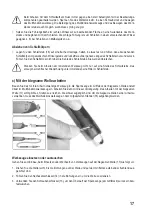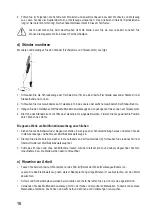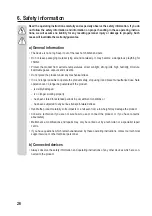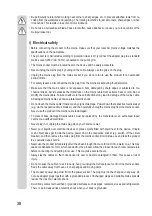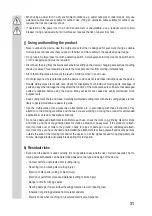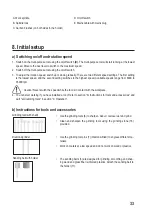
28
f) Safety instructions
• Keep the mains cable away from rotating tools. If you lose control of the device, the mains cable may be
cut or snagged and your hand or arm may be pulled into the rotating tool.
• Never put the multi-purpose tool down until the tool attachment has come to a complete standstill. The
rotating tool may come into contact with the work surface, which may cause you to lose control of the
multi-purpose tool.
• Do not run the multi-purpose tool when carrying it to another location. Your clothes may become trapped
by accidental contact with the rotating tool, and the tool may drill into your body.
• Use vices, clamps or other practical devices to secure a workpiece and attach it to a stable surface.
Holding the workpiece by hand or against your body will cause it to become unstable and may lead to
loss of control and potential injuries.
• To reduce the risk of explosion, electric shock and damage to property, always check the work area for
hidden gas pipes, electrical wires or water pipes when making a blind cut on installed parts.
• Keep your hands away from all cutting edges and moving parts. Do not reach underneath the workpiece.
• Make sure that other people maintain a safe distance from your work area. Anyone entering the work
area must wear personal protective equipment.
• Fragments of the workpiece or broken tools may be ejected and cause injuries, including to people who
are outside the immediate work area.
• Do not use blunt or damaged tools. They can cause excessive friction, blade binding and kickback.
• Familiarise yourself with the workpiece. Remove/saw nails and screw heads before grinding. Hard and
hidden objects with a blade may cause the tool to kick back.
• Prevent dust from accumulating in your work area. Dust can easily ignite. Fire hazard!
• Use the multi-purpose tool exclusively for dry sanding. Do not grind wet materials, as water may pen-
etrate into the multi-purpose tool and damage the interior components.
• Wear a dust mask, especially when working with the following materials:
- Lead from lead-based paint
- Crystalline silica from bricks, cement and other masonry products
- Arsenic and chromium from chemically-treated lumber
• Inhaling these harmful/toxic dusts can damage your health and the health of others. The risk from con-
tact with these chemicals varies depending on the frequency of your exposure. To reduce your exposure
to these chemicals: work in a well ventilated area, and work with approved personal protective equip-
ment (PPE), such as dust masks that are specially designed to filter out microscopic particles.
• Use a dust mask, hearing protection, protective gloves or a special apron that keeps small grinding and
material particles away from you. The eyes must be protected against foreign objects, which may be
ejected in a range of different applications. Dust or respiratory masks must be able to filter the dust cre
-
ated during use. Prolonged exposure to loud noise may lead to hearing loss.




